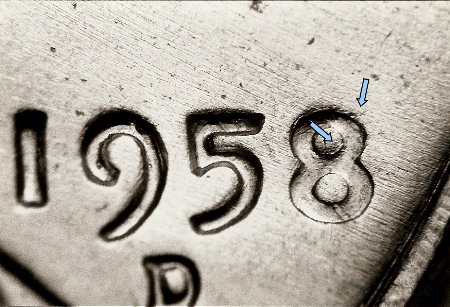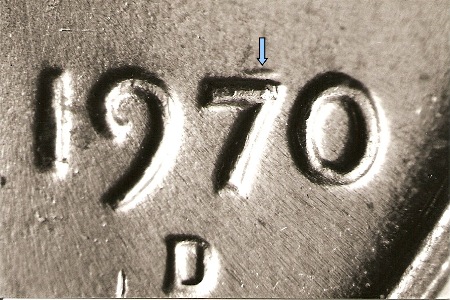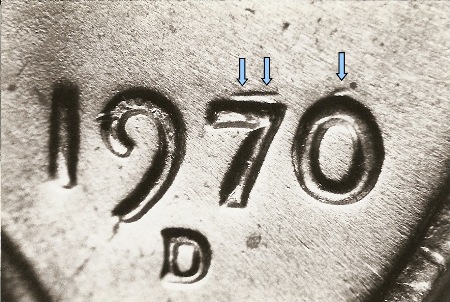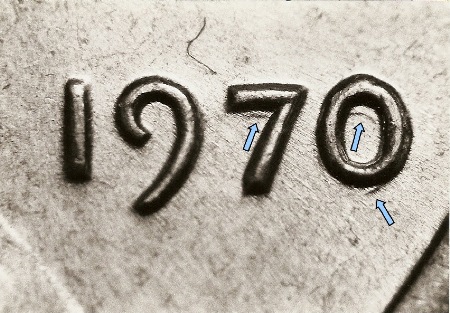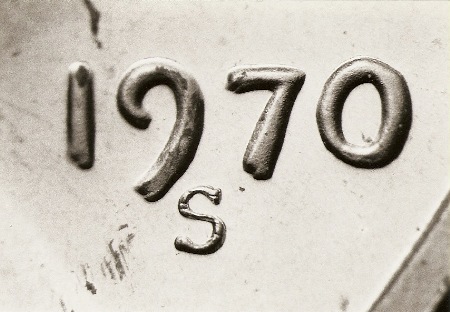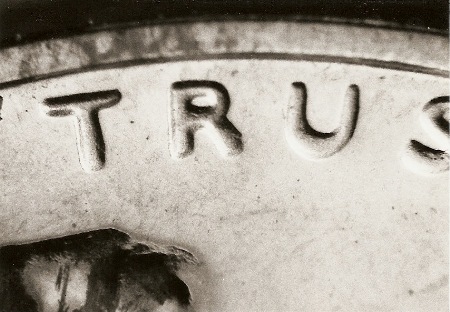


 |
 |
 |
 |
 |
 |
 |
 |
 |
 |
 |
 |
 |
 |
 |
 |
 |
 |
 |
 |
 |
 |
 |
 |
This class of doubled die varieties may well be a class with no actual known varieties! This class of doubled dies got its name "modified hub doubling" due to the fact that the doubling would result from some sort of modification to a part of the coin design on one or more of the working hubs. As such, this is a very difficult class to verify and would most likely require some sort of confirmation from the Mint that modifications were indeed made to a working hub. Years ago there were a few suspected examples of this type of doubling, but they have since been delisted as Class VII doubled die varieties. The first "variety" once believed to be a Class VII doubled die variety is the so-called 1958/7 Lincoln cent overdate variety. This alleged variety shows what appears to be remnants of a 7 under the 8 and was first noticed on 1958 D-Mint cents. Alan Herbert first reported on the variety in the July 15, 1978 issue of Numismatic News Weekly. According to the account the Mint indicated that the master hub became unusable after making the master die for 1957. They didn't want to make a new master hub as they were used for a period of several years at that time and there was some uncertainty at the time over possible obverse design changes for the Lincoln cents in 1959 due to the coming of the Lincoln Memorial cents. Rather than make a new master hub the Mint reportedly took a working hub for 1957, ground off the 7, and used it to make a master die for 1958. The 8 was then engraved into the master die to complete it. It sounds like this should be the real deal, however, research during the latter part of the 1980's suggested that the so-called remnants of a 7 were nothing more than some die gouges and/or die scratches. Today none of the leading die variety specialists believe that it is an 8/7 variety. Apparently the Mint did an excellent job in removing the 7 from the 1957 working hub and no real remnants of the 7 were left behind. Specimens of this refuted overdate can still be found for sale so buyer beware!
Once thought to be remnants of a 7 under the 8, die variety specialists today believe that the alleged remnants of the 7 are nothing more than die gouges and/or die scratches. It is not the overdate that it was once thought to be. The other example of what was once thought to be Class VII doubling can be found on various 1970 dated Lincoln cents. Cents from all three Mints were found with doubling of the 7, or doubling of the 0, or even doubling of both the 7 and the 0. It was once thought that when the Mint switched from the Small Date to the Large Date in 1970, the 70 in the date (or possibly the entire date) was ground off of the working hub that was used to make the Small Date working dies. However, the removal of the 70 in the date did not remove all traces of the 7 and 0. Rather than waste an otherwise good working hub, this modified hub was then supposedly used to make first hubbings into working dies. The remaining impressions were then made with newer Large Date hubs. While it seemed to be a plausible explanation at the time given the number of varieties that were found showing doubled 7's and 0's, as more and more of these varieties were found, the evidence on the coins did not support the modified hub theory. There are too many different variations to the doubling including doubling to just the 7 where the doubling is above the top of the 7, doubling to just the 7 where the doubling is below the top of the 7, doubling to just the 0 where the doubling is above the top of the 0, doubling to just the 0 where the doubling is below the top of the 0, doubling to the 7 and 0 where the doubling is above the 70, and doubling to the 7 and 0 where the doubling is below the 70. Some may be explained by additional class movements such as pivots, but that would not take into account the differences in how much doubling was being seen.
This is the doubled die that we have listed as 1970-D 1¢ WDDO-008. The doubling seen above the 7 was once thought to be the remnants of a 7 from a Small Date hub. Varieties such as this were listed as "Large Date over Small Date" varieties, and/or "Low 7 over Level 7" varieties.
Here we see very similar doubling above the 7 on the doubled die that we have listed as 1970-D 1¢ WDDR-012. Other similarly doubled varieties are in the files for both the 1970 P-Mint and S-Mint cents. A modified hub could explain these two varieties as they are very similar, but not all 1970 doubled dies have this appearance.
The 1970-D cent that we have listed as 1970-D 1¢ WDDO-018 shows similar doubling to the 7, but also shows doubling above the 0 which is not seen on the two previous varieties.
Here is a 1970 P-Mint cent that we have listed as 1970 1¢ WDDO-005. It too shows a doubled 7 and 0, but this time the doubling is below the top of the 7 and 0 and much more of the 0 can be seen. Other varieties show just a 7 below the top of the 7, or just a 0 above the top of the 0, or just a 0 below the top of the 0. Probably the most damaging evidence to the modified hub theory for these "doubled 70" varieties came when Mike Ellis discovered that the 1970-S proof Lincoln cent doubled die variety listed as 1970-S 1¢ Pr WDDO-003 is a Class III doubled die rather than a Class VI doubled die. Ellis discovered, and other die variety specialists confirmed, that 1970-S 1¢ Pr WDDO-003 is actually a Large Date hubbed over a Small Date. Strong doubling can be found on the date, the letters of LIBERTY, and even the letters of IN GOD WE TRUST. That doubling shows rather convincingly that two different designs exist between the 1970-S Small Date cents and the 1970-S Large Date cents. If that Small Date hub really had been modified as once suggested, the doubling seen on LIBERTY and IN GOD WE TRUST on 1970-S 1¢ Pr WDDO-003 should also show on the previously illustrated "doubled 70" varieties. However, none of them show any evidence of this additional doubling.
This is 1970-S 1¢ Pr WDDO-003 which it is now recognized as a Large Date hubbed over a Small Date. The doubling of the 7 and 0 does not support the modified hub theory for what is seen on the previously illustrated varieties.
The doubling on LIBERTY on 1970-S 1¢ Pr WDDO-003 does not support the modified hub theory for the "doubled 70" varieties found on the 1970 Lincoln cents.
The doubling on IN GOD WE TRUST on 1970-S 1¢ Pr WDDO-003 also does not support the modified hub theory for the "doubled 70" varieties found on the 1970 Lincoln cents. To the best of my knowledge, no other doubled die varieties have been suspected as being the result of a modified hub. The likelihood of a modified hub being used to produce dies in the single-squeeze hubbing era would seem to be zero. Consequently, this may well remain the only class of doubled die varieties that has no listings. Go To: | ||


